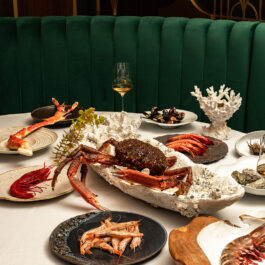Food
What The Feijoa? 15 Unusual Fruits And How To Eat Them
Slide Nr 1Sure, keeping it local is on-trend, with eco-conscious foodies gravitating towards regional, organic fruit. However, local is relative and sometimes expanding your taste horizon is just as important as counting food miles. Whether you’re travelling abroad or exploring the exotic fruit aisle, see if these delicious misfits pass the taste test.
0/16
Food
What The Feijoa? 15 Unusual Fruits And How To Eat Them.
Slide Nr 2Jackfruit (Artocarpus heterophyllus) – Vegans may recognise the jackfruit as an awe-inspiring meat replacement. The young fruit (found canned in Asian supermarkets) doesn’t have much flavour, but comes into its own in recipes like pulled jackfruit or jackfruit tacos. The ripe fruit, however, is sweet, juicy, tasty – oh, and absolutely huge!
1/16
Food
What The Feijoa? 15 Unusual Fruits And How To Eat Them.
Slide Nr 3Cocoa (Theobroma cacao) – No, this isn’t one of those jokes about a bar of chocolate and a glass of wine counting as two of your five a day. The stuff we commonly refer to as cocoa comes from the cacao fruit – and the pulp of that fruit can be used to make a refreshing and invigorating juice. It’s hard enough to find dried or frozen cocoa pulp, but to taste it fresh you’ll really have to go somewhere cacao is grown.
2/16
Food
What The Feijoa? 15 Unusual Fruits And How To Eat Them.
Slide Nr 4Cupuaçu (Theobroma grandiflorum) – Cocoa’s close relation cupuaçu is common across the Amazon basin and popular in countries like Bolivia, Brazil, Colombia and Peru for its medicinal and cosmetic qualities, but also the flavour of its ripe flesh. Elsewhere, it’s only readily available as a butter similar to cocoa butter or as a “superfood“ powder for use in smoothies and the like. [Photo: cupuaçu-fruit/Flickr]
3/16
Food
What The Feijoa? 15 Unusual Fruits And How To Eat Them.
Slide Nr 5Medlar (Mespilus germanica) – Eurocentrics may choff at the medlar being called an unusual or exotic fruit. On the other hand, they may well never have heard of it. Although the fruit is native to southwestern Asia and southeastern Europe and has been name-checked by everyone from Chaucer and Shakespeare to Lawrence and Nabokov, it has fallen out of fashion and is impossible to find in even the most specialised fruit markets. Most likely this is down to the fact that the medlar is at its most delicious when it looks like it’s ready to rot off the tree. The less off-putting term for this is ‘bletting’, which refers to a softening process that brings out the sweetness and rich flavours of the otherwise hard and sour fruit.
4/16
Food
What The Feijoa? 15 Unusual Fruits And How To Eat Them.
Slide Nr 6Mangosteen (Garcinia mangostana) – If the name mangosteen sounds familiar, it’s probably because it’s a popular choice for Asian restaurant names around the world. Or maybe you tasted the delicate white flesh hiding inside a hard purple skin while travelling and can’t get the delicious flavour out of your head? Either way, whilst the Mangosteen is ubiquitous in tropical Southeast Asia, fresh fruit can be hard to find in other places. Your best shot is Northern Hemisphere winter, when they are in season.
5/16
Food
What The Feijoa? 15 Unusual Fruits And How To Eat Them.
Slide Nr 7Ackee (Blighia sapida) – Ackee may rhyme with icky, but that only applies to the unripened fruit and certain inedible parts, which are toxic. When ripe, the so-called aril, the fleshy appendage to the large black seeds, becomes the staple ingredient of Jamaica’s national dish. Much like breadfruit, the other unusual fruit popular in Jamaica, ackee is cooked like a vegetable and the end result is something else altogether. It’s most commonly compared to scrambled egg. [Photo: kaiton/Flickr]
6/16
Food
What The Feijoa? 15 Unusual Fruits And How To Eat Them.
Slide Nr 8Horned Cucumber (Cucumis metuliferus) – The love child of a diabolic melon and a seedy cucumber doesn’t just look amazing, it tastes equally intriguing. Eat it early in the ripening process for a more savoury, cucumber-ish flavour, or at a later stage for a sweeter, melon-y taste. It’s become a bit easier to find on supermarket shelves globally, but is still most common in Africa.
7/16
Food
What The Feijoa? 15 Unusual Fruits And How To Eat Them.
Slide Nr 9Durian (Durio zibethinus) – You’ve probably heard of the durian, but we’re including it in this list because it’s often known for all the wrong reasons. While Westerners are most likely to know it as the stinkfruit, a novelty trotted out for tourists in Thailand to turn their noses up at, in Southeast Asia it’s revered as the king of fruits. Try its super sweet, intense custard flavour at least once before giving it the pass. It can be found fresh, canned or in various processed forms in Asian supermarkets.
8/16
Food
What The Feijoa? 15 Unusual Fruits And How To Eat Them.
Slide Nr 10Miraclefruit (Synsepalum dulcificum) – You may have heard of the use of miraclefruit at flavour tripping parties, where participants eat the berry in some form, followed by sour food. Oh miracle of miracles, sour suddenly tastes sweet and everyone “trips” out. How does this amazing fruit work and why isn’t it in everyone’s pantry at this stage? It blocks the sour taste receptors and activates those that respond to sweetness, but in many countries it hasn’t been approved for sale as a food.
9/16
Food
What The Feijoa? 15 Unusual Fruits And How To Eat Them.
Slide Nr 11Buddha’s Hand (Citrus medica var. Sarcodactylis) – Now, the obvious thing would be to try this trippy lemon as part of a flavour tripping party, but that would be a bit of a waste, as the so-called “fingered citron” is quite hard to come by and has a unique flavour worth experiencing in its own right. Although – granted – the most remarkable thing about it is the shape, which gave it the nickname Buddha’s Hand in China, Japan and Korea.
10/16
Food
What The Feijoa? 15 Unusual Fruits And How To Eat Them.
Slide Nr 12Feijoa (Acca sellowiana) – The feijoa’s nicknames – pineapple guava or guavasteen – tell you all you need to know about its flavour. Despite its South American origins, it’s currently best known for New Zealand growers’ efforts to make the fruit – which is not entirely dissimilar to kiwis – a “thing”.
11/16
Food
What The Feijoa? 15 Unusual Fruits And How To Eat Them.
Slide Nr 13Jabuticaba (Plinia cauliflora) – These “Brazilian grapes” taste, as that name would suggest, similar to grapes. Unfortunately, they aren’t as easy to cultivate and transport, so the fresh fruit is rarely for sale – and even then, only in season. The real quirk is the way the fruit grows out of the tree trunk, making it look like something Dr. Seuss might have dreamt up.
12/16
Food
What The Feijoa? 15 Unusual Fruits And How To Eat Them.
Slide Nr 14Monster Fruit (Monstera deliciosa) – Everyone knows this plant: it’s been painted by world-famous artists, and its leaves adorn everything from wallpaper to summer dresses. But few are aware of the fact that, in its rainforest home, it bears the fruit that inspired its botanical name. They can be monstrously large and taste deliciously sweet.
13/16
Food
What The Feijoa? 15 Unusual Fruits And How To Eat Them.
Slide Nr 15Aguaje Fruit (Mauritia flexuosa) – The scaly red shell of the aguaje hides a firm flesh that isn’t particularly sweet – in fact, it’s often eaten with sugar or used in jams, juices and wines. The superfoods gold rush has led to it being labelled “curvy fruit”, supposedly capable of enhancing a womanly shape. Seeing as there’s no scientific evidence to back up that claim, we’ll just stick to the fact that it’s highly nutritious and tasty.
14/16
Food
What The Feijoa? 15 Unusual Fruits And How To Eat Them.
Slide Nr 16Langsat (Lansium parasiticum) – Langsat – and a different cultivar of the same plant, duku – is grown across Southeast Asia. For want of a better comparison, the fruit can be described as the plain Jane sister to the lychee. The translucent white flesh is protected by a hard shell – but a rather drab beige one. They are only a little sweet, with sour and bitter notes. The riper, the sweeter.
15/16
Food
What The Feijoa? 15 Unusual Fruits And How To Eat Them.
Slide Nr 1816/16















Sorry, the comment form is closed at this time.